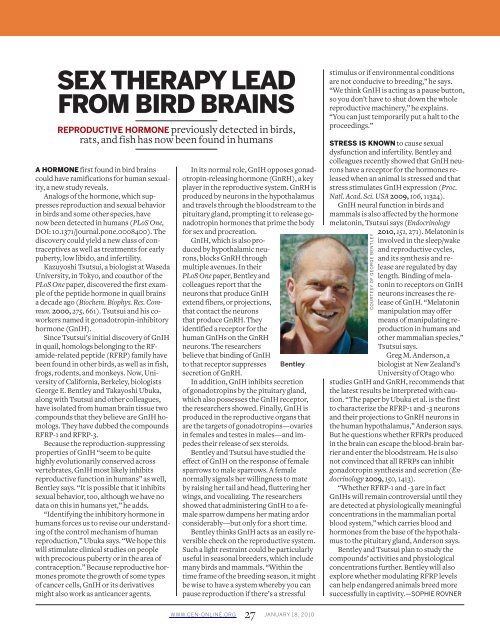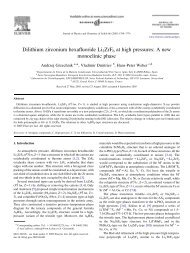Chemical & Engineering News Digital Edition - January 18, 2010
Chemical & Engineering News Digital Edition - January 18, 2010
Chemical & Engineering News Digital Edition - January 18, 2010
You also want an ePaper? Increase the reach of your titles
YUMPU automatically turns print PDFs into web optimized ePapers that Google loves.
SEX THERAPY LEAD<br />
FROM BIRD BRAINS<br />
REPRODUCTIVE HORMONE previously detected in birds,<br />
rats, and fish has now been found in humans<br />
A HORMONE first found in bird brains<br />
could have ramifications for human sexuality,<br />
a new study reveals.<br />
Analogs of the hormone, which suppresses<br />
reproduction and sexual behavior<br />
in birds and some other species, have<br />
now been detected in humans ( PLoS One,<br />
DOI: 10.1371/journal.pone.0008400). The<br />
discovery could yield a new class of contraceptives<br />
as well as treatments for early<br />
puberty, low libido, and infertility.<br />
Kazuyoshi Tsutsui, a biologist at Waseda<br />
University, in Tokyo, and coauthor of the<br />
PLoS One paper, discovered the first example<br />
of the peptide hormone in quail brains<br />
a decade ago ( Biochem. Biophys. Res. Commun.<br />
2000, 275, 661). Tsutsui and his coworkers<br />
named it gonadotropin-inhibitory<br />
hormone (GnIH).<br />
Since Tsutsui’s initial discovery of GnIH<br />
in quail, homologs belonging to the RFamide-related<br />
peptide (RFRP) family have<br />
been found in other birds, as well as in fish,<br />
frogs, rodents, and monkeys. Now, University<br />
of California, Berkeley, biologists<br />
George E. Bentley and Takayoshi Ubuka,<br />
along with Tsutsui and other colleagues,<br />
have isolated from human brain tissue two<br />
compounds that they believe are GnIH homologs.<br />
They have dubbed the compounds<br />
RFRP-1 and RFRP-3.<br />
Because the reproduction-suppressing<br />
properties of GnIH “seem to be quite<br />
highly evolutionarily conserved across<br />
vertebrates, GnIH most likely inhibits<br />
reproductive function in humans” as well,<br />
Bentley says. “It is possible that it inhibits<br />
sexual behavior, too, although we have no<br />
data on this in humans yet,” he adds.<br />
“Identifying the inhibitory hormone in<br />
humans forces us to revise our understanding<br />
of the control mechanism of human<br />
reproduction,” Ubuka says. “We hope this<br />
will stimulate clinical studies on people<br />
with precocious puberty or in the area of<br />
contraception.” Because reproductive hormones<br />
promote the growth of some types<br />
of cancer cells, GnIH or its derivatives<br />
might also work as anticancer agents.<br />
In its normal role, GnIH opposes gonadotropin-releasing<br />
hormone (GnRH), a key<br />
player in the reproductive system. GnRH is<br />
produced by neurons in the hypothalamus<br />
and travels through the bloodstream to the<br />
pituitary gland, prompting it to release gonadotropin<br />
hormones that prime the body<br />
for sex and procreation.<br />
GnIH, which is also produced<br />
by hypothalamic neurons,<br />
blocks GnRH through<br />
multiple avenues. In their<br />
PLoS One paper, Bentley and<br />
colleagues report that the<br />
neurons that produce GnIH<br />
extend fibers, or projections,<br />
that contact the neurons<br />
that produce GnRH. They<br />
identified a receptor for the<br />
human GnIHs on the GnRH<br />
neurons. The researchers<br />
believe that binding of GnIH<br />
to that receptor suppresses<br />
secretion of GnRH.<br />
Bentley<br />
In addition, GnIH inhibits secretion<br />
of gonadotropins by the pituitary gland,<br />
which also possesses the GnIH receptor,<br />
the researchers showed. Finally, GnIH is<br />
produced in the reproductive organs that<br />
are the targets of gonadotropins—ovaries<br />
in females and testes in males—and impedes<br />
their release of sex steroids.<br />
Bentley and Tsutsui have studied the<br />
effect of GnIH on the response of female<br />
sparrows to male sparrows. A female<br />
normally signals her willingness to mate<br />
by raising her tail and head, fluttering her<br />
wings, and vocalizing. The researchers<br />
showed that administering GnIH to a female<br />
sparrow dampens her mating ardor<br />
considerably—but only for a short time.<br />
Bentley thinks GnIH acts as an easily reversible<br />
check on the reproductive system.<br />
Such a light restraint could be particularly<br />
useful in seasonal breeders, which include<br />
many birds and mammals. “Within the<br />
time frame of the breeding season, it might<br />
be wise to have a system whereby you can<br />
pause reproduction if there’s a stressful<br />
WWW.CEN-ONLINE.ORG 27 JANUARY <strong>18</strong>, <strong>2010</strong><br />
stimulus or if environmental conditions<br />
are not conducive to breeding,” he says.<br />
“We think GnIH is acting as a pause button,<br />
so you don’t have to shut down the whole<br />
reproductive machinery,” he explains.<br />
“You can just temporarily put a halt to the<br />
proceedings.”<br />
STRESS IS KNOWN to cause sexual<br />
dysfunction and infertility. Bentley and<br />
colleagues recently showed that GnIH neurons<br />
have a receptor for the hormones released<br />
when an animal is stressed and that<br />
stress stimulates GnIH expression ( Proc.<br />
Natl. Acad. Sci. USA 2009, 106, 11324).<br />
GnIH neural function in birds and<br />
mammals is also affected by the hormone<br />
mel atonin, Tsutsui says ( Endocrinology<br />
<strong>2010</strong>, 151, 271). Melatonin is<br />
involved in the sleep/wake<br />
and reproductive cycles,<br />
and its synthesis and release<br />
are regulated by day<br />
length. Binding of melatonin<br />
to receptors on GnIH<br />
neurons increases the release<br />
of GnIH. “Melatonin<br />
manipulation may offer<br />
means of manipulating reproduction<br />
in humans and<br />
other mammalian species,”<br />
Tsutsui says.<br />
Greg M. Anderson, a<br />
biologist at New Zealand’s<br />
University of Otago who<br />
studies GnIH and GnRH, recommends that<br />
the latest results be interpreted with caution.<br />
“The paper by Ubuka et al. is the first<br />
to characterize the RFRP-1 and -3 neurons<br />
and their projections to GnRH neurons in<br />
the human hypothalamus,” Anderson says.<br />
But he questions whether RFRPs produced<br />
in the brain can escape the blood-brain barrier<br />
and enter the bloodstream. He is also<br />
not convinced that all RFRPs can inhibit<br />
gonadotropin synthesis and secretion ( Endocrinology<br />
2009, 150, 1413).<br />
“Whether RFRP-1 and -3 are in fact<br />
GnIHs will remain controversial until they<br />
are detected at physiologically meaningful<br />
concentrations in the mammalian portal<br />
blood system,” which carries blood and<br />
hormones from the base of the hypothalamus<br />
to the pituitary gland, Anderson says.<br />
Bentley and Tsutsui plan to study the<br />
compounds’ activities and physiological<br />
concentrations further. Bentley will also<br />
explore whether modulating RFRP levels<br />
can help endangered animals breed more<br />
successfully in captivity. —SOPHIE ROVNER<br />
COURTESY OF GEORGE BENTLEY




